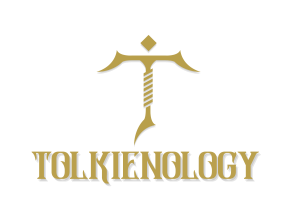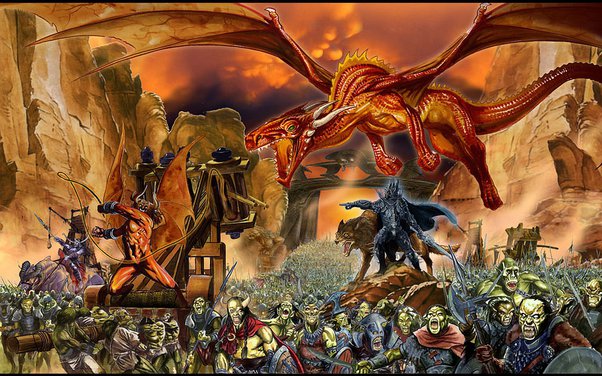During the Third Age, many beasts roamed Middle Earth, primarily the Orcs that make up the main armies of Sauron, led by his servant, Saruman the White. Little is told during the War of The Ring on the origins of these Orcs, but we know they come from ancient origins before Sauron came to full power in Mordor. However, with the Third Age and the One Ring coming into focus, Saruman forms a new army called the Uruk-Hai to track down the ringbearer and bring them back, a strategy of creation his old master, Melkor put to practice. During the journey of the Fellowship, they venture through the Mines of Moria, encountering many Orcs occupying the once thriving Dwarf city, but what forces the fear into the Orcs, as well as the Fellowship, even Gandalf himself, is Durin’s Bane- or better known as a Balrog. A fire demon-like beast with a sword of fire and a whip engulfed in flames.
Finally, when Frodo is in Cirith Ungol, tricked by Gollum; he is stung by Shelob a giant spider occupying the caves of Cirith Ungol. Wrapped in her web and found by the Orcs of Mordor. Even during The Hobbit, Bilbo Baggins encounters Smaug living in the depths of The Lonely Mountains. All these beasts occupied and settled for many years in the areas conquered by the Darkness of Sauron, but all of them are a foldover of older ages. Corrupted or allegiances formed by the first Dark Lord, Melkor (Morgoth), whom Sauron acted as a lieutenant for in Angband. In this article, I will explore the origins of these beasts, how they began to play a role in Middle Earth, how they fell into the hands of Melkor himself, and how he created such foul beasts to gain the upper hand on his enemies.
Coming of the Orcs
To begin with, it is fitting that I go back to the corruption of the Elves, forming the Orcs.
During the Years of the Tree, before the forming of the first age, the Elves formed in Cuiviénen; dwelling there for fifty Valian Years, until the spies of Melkor found the Elves and captured those that did not manage to hide or escape. Those that were unlucky enough to be captured by Melkor, were tortured and mutilated within the Fortress of Angband. Melkor formed the Orcs from corrupted Elves in mockery of the Children of Iluvatar. With deformed bodies and hearts of granite, their minds were tortured to no longer believe they were Elves, but in fact Orcs. Another translation of Tolkien’s suggests that this act was committed in Utumna, rather than Angband. The Orcs would serve Melkor out of fear rather than loyalty. However, when Melkor is chained and taken away by the Arda, without control from their master, the Orcs were free to spread across Middle earth. Even though Melkor was imprisoned, his lieutenant Sauron, continued to breed Orcs and when Melkor returned, he was welcomed by a large host of Orcs to command. Continuing after Melkor’s banishment into the void, Sauron takes power in Mordor and began using the Orcs as his main force in the Third Age and during the War of the Ring.
Ungoliant the Gloomweaver
Ungoliant was a spirit in spider form, believed to have been corrupted by Melkor. It is said that she took the form of a giant spider after escaping the hunters of Oromë, fleeing to a ravine South of the mountain Hyarmentir. After Melkor found Ungoliant, he used her to have his revenge against the Valar and Elves after his imprisonment, convincing her to drink the light of the Two Trees of the Valinor. As her reward- though Ungoliant was ambivalent towards Melkor’s plan- he promised that she could have her feed on whatever she desired. Upon their arrival to Ezzelohar, Ungoliant drank the light from the Two Trees and drank dry the Wells of Varda. This act caused Ungoliant to grow to such a size, that even Melkor grew afraid of her.
When both Melkor- who was now known as Morgoth- and Ungoliath arrived at Lammoth; he left his promise to Ungoliath unfulfilled. Out of anger at his betrayal, Ungoliath demanded the gems Morgoth possessed and when she consumed them, she grew to a more monstrous size. Now demanding that Morgoth give her the Silmarils, Morgoth refused; and attempting to trap him in her web, Morgoth let out a cry in pain, which was heard by the Balrogs that were hibernating under the ruins of Angband. The Balrogs came to the aid of Morgoth, causing Ungoliath to flee. During her escape, the Balrogs attempted to chase and kill her, but they were stopped by Morgoth, who summoned them to join him in Angband.
Ungoliant fled to Nan Durgortheb where she bred with giant spiders of her kind, spreading her kind in vast numbers. The area of Nan Durgortheb would soon become infested by these giant spiders who became the offspring and descendants of her, including Shelob, who would later make an appearance in the Third Age. Ungoliath out of hunger met her demise by devouring herself.
Balrogs
Another name for the Balrog is Valaraukar, created by the Iluvatar as Ainur. They were Maiar, the same race as Sauron. They are lesser spirits of the Valar and joined Melkor when he turned on them during the creation of the world. It is not known how many Balrogs existed in Middle Earth during the First Age, (perhaps only six or seven) but they became the most feared servants of Morgoth. During the War of Wrath, most of the Balrogs were destroyed by the Valar; however, some escaped and hid in different areas of Middle Earth. We notice that in the beginning, upon the approach of the Balrog on the Fellowship, that darkness falls upon them. It is not until they are on the bridge, do we see the Balrog ascend into flame presenting its sword and fiery whip. Proving that Balrogs are not just spirits of fire but can shroud areas in darkness.
The lord of the Balrogs, whom we know as Gothmog played a role in the fall of Gondolin, but was slain by Ecthelion, who also would lose his life during the fight. After the sacking of Gondolin by Morgoth’s order, Tuor and Idril led the survivors to safety, but would also encounter another Balrog that was slain by Glorfindel. Glorfindel would soon succumb to the injuries of the Balrog and die.
Not much is mentioned of the Balrogs after the sack of Gondolin, until the War of Wrath, when the Valar release their full power on Angband. This brought an end to the reign of Morgoth and all his Balrogs were destroyed except one, who escaped and hid in the Misty Mountains, and would remain there for thousands of years. The only documented Balrog that we know of after the First Age came to an end, was Durin’s Bane. This is the same Balrog killed by Gandalf, after the death of Durin’s Bane in Moria, there is no report of a surviving Balrog. Therefore, we can only assume Gandalf killed the last surviving Balrog.
The Werewolves of Angband
Drauglin was the lord of wolves in Angband, a servant to Sauron himself. Thus, he became the first corrupted Werewolf. He was known to be old and evil, corrupted by the Wolves of Beleriand. He was slain by Haun the Hound and his pelt was used by Beren in the quest for the Simarils.
Carcharoth may sound familiar if you have read Beren and Luthien, as Carcharoth is the Werewolf who bit off the hand of Beren. Carcharoth was lord and sire of the Werewolves of Angband who came from the race of Draugluins, meaning he was a bigger Werewolf than normal. Created and raised by Morgoth himself he grew to a great size and power and was used to defend against Huan. However, on the quest to retrieve the Simarils, he was enchanted by Luthien and fell into a deep sleep. When Beren and Luthien left Angband, he awoke and bit off the hand of Beren, consuming Morgoth’s crown still held within Beren’s hand. The Simarils burnt his insides, driving him mad. Escaping from Angband, he began terrorising Orcs, Elves, and Men killing all that stood in his way.
It wasn’t until the Hunt of the Werewolves, Carcharoth was slain by the hand of Huan the Hound.
Dragons of Angband
When Morgoth faced attacks at Angband, he knew that Orcs would not win his wars alone against the Noldor, so he created a more dangerous weapon to see the end of battles against the Noldor and aid his conquest; the dragon Glaurung, the father of the Dragons. It is not known exactly when Glaurung was created, but his first appearance came prematurely and against Morgoths wishes. Even though the dragon was still young and not at its full power, it still pushed the Noldor back to Dorthonion and Ered Wethrin. Although the young dragon brought fear to Noldor, it was driven back to Angband by Fingon who rode against it with mounted archers. Glaurung was kept from leaving Angband for some 200 years.
Glaurung was known as the Great Worm as he had no wings but still fought well in the Battles of Beleriand- a war against the High Elves which Glaurung led Orcs with Balrogs. It was during Nirnaeth Arnoediad that Glaurung discovered that he had dark powers, his eyes having a binding power, as well as a hypnotic spell. Thereafter, Morgoth appointed Glaurung to watch over all new lands.
With his newly discovered powers, Morgoth commanded Glaurung to end the Sack of Nargothrond. However, it was Turin Turambar who met him at the gates, and before Turin could fight, Glaurung had put him under a hypnotic spell, forcing him to hear the cries of Finduilas as she was being taken away by the Orcs. Glaurung then gave Turin two options: to rescue Finduilas or rescue his mother and sister who were in Dor-Lomin.
After some years had passed, Glaurung attacked near the home of Turin Turambar, Turin went on a hunt for the dragon, accompanied by two men; however, one fled in fear of Glaurung, the other crushed by rocks. Turin, wielding his sword Gurthang, thrust it deep into Glaurung’s belly. After crying with pain, Glaurung died.
The second dragon to be created by Morgoth was the largest and mightiest of dragons, Ancalagon the Black- the first of the winged dragons. Ancalagon came into power during the War of Wrath, the final war against Morgoth by the Valar. When most of the Balrogs and forces of Morgoth had been destroyed, it was Ancalagon’s presence that encouraged the retreat of the Host of the Valar, attacking with fire and thunderbolts. It was not until Eärendil killed Ancalagon- smashing into the towers of Tharangorodrim did the Hosts of Valar see victory at hand.
The name of Ancalagon is mentioned again in the Third Age, when Gandalf informs the Council of Elrond that not even the fires of Ancalagon could destroy the One Ring.







